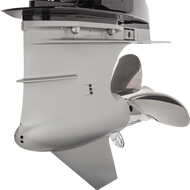High-Performance Outboard Lower Units
High-Performance Outboard Lower Units
You all know that a boat goes faster when you trim an outboard higher. Less gear case in the water equals less drag, and since drag is inversely proportional to speed, the faster you go, the more drag the lower unit creates. Trimming out also raises the bow, cutting drag even more by reducing wetted surface. Some boaters reduce drag by adding a jack plate to raise the mounting height.
The biggest limiter is keeping water flowing into the cooling intakes. Racers and hotdog anglers have for years used low water pickups to allow increased trim and height. Another way to increase speed is to make the lower unit more “slippery.”
Until recent years, there were only two options to get these features in an outboard lower unit — buy a Mercury Racing outboard fitted with a special Sport Master or Torque Master gear case, or modify the lower unit with a kit. Today, however, a number of outboard builders offer models with high-performance lower units on production models.
Mercury Marine was one of the first to go mainstream, borrowing engineering from its Racing Division to create additional water pickups in the nose of the gear-case torpedoes on production models, including some OptiMax and Verado outboards.
Other outboard brands followed suit. For example, Evinrude’s SLE gear case is standard on its E-Tec High Output engines. Yamaha’s VMax SHO models have specially engineered SST lower units, and Suzuki recently debuted a high-performance gear case for its DF 300 outboard.
In addition to pickups on the nose of each, the torpedo projects forward into a sharply pointed nose cone, like that of a supersonic jet fighter. Combined with a slender strut and skeg (each with sharp leading edges), this shape slips through the water more easily than the rounded noses found on other outboards. The leading edge of the strut has a vertically concave shape, allowing it to meld smoothly with the protruding nose cone. At what speed does such a high-performance lower unit make a difference?
You probably won’t notice much at speeds below 65 mph, but even at higher speeds, the improvements will be incremental — 1 or 2 mph, or fractions thereof. So if you’re not a speed demon, highly streamlined lower units won’t do much for you, except perhaps impress your buddies.
That’s why outboard companies reserve these lower units for high-performance models — engines typically run on tournament-style bass boats or multiengine center consoles designed to compete in kingfish-style events, in which getting to the fish first and back to weigh-in on time is critical. A small difference in speed here can make a big difference in the payday. And that’s why competitors like lower units that are slippery when wet.
Posted by Mercury Marine


